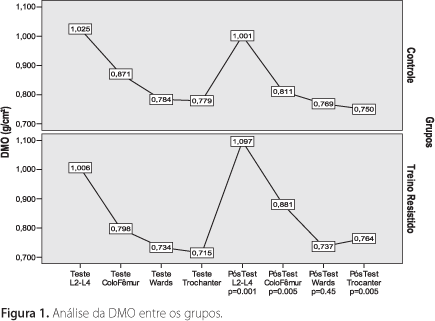Osteoporosis is a chronic disease of the human skeleton. OBJECTIVE: To verify the effects of resistance training on bone mineral density (BMD), muscular strength, balance and quality of life in menopausal women taking Alendronate. MATERIALS AND METHODS: Sixteen female volunteers participated in the study. The volunteers were separated into two groups: resistance training participants (n=9; 49.7±4.2 years) and control group (n=7; 53.8±4.4 years). The following evaluation instruments were used: absorptiometry-DXA (which measured the lumbar spine L2-L4, neck femur, Wards triangle and major trochanter), the Osteoporosis Assessment Questionnaire (OPAQ) and a balance test. The training was applied in 12 months, divided in six cycles with intensity of 70-90% of the maximum load (10RM). Parametric tests for intra-group analysis (t or Wilcoxon) and (Anova) for inter-groups, were used. RESULTS: Significant differences in the resistance training group were found in the bones variables: lumbar L2-L4 (6.8%, p=0.001), neck femur (4.8%, p=0.005) and trochanter (0.76%, p=0.005). In addition, significant differences were also found for body balance (21.4%, p=0.001), quality of life (9.1%, p=0.001) and all muscular strength measurements, such as in leg press 45° (49.3%, p<0.001). CONCLUSION: The results suggest that the methodology applied to resistance training can be recommended for menopausal women with low BMD.
resistance training; bone mineral density; body balance; muscular strength; quality of life




